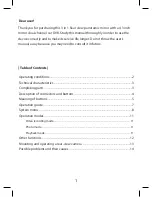
SVS-VISTEK
Feature-Set
40
7.1.4
Rolling Shutter
Rolling shutter is a method of reading out a CMOS sensor, where the
whole scene is scanned line after line very rapidly. Rolling shutter cameras
in general are more sensitive in their light response than global shutter
ones.
Despite the speed of scanning one line after the other („rolling“) is very
high, it is important to note that the instant of imaging a single line will be
different to the point of time of the next line imaging. As this works out
without any effect in the final image with still sceneries, with moving
objects you get geometric distortions (see example of rotating propeller),
showing fast moving structures in an predictable, in the first moment yet
surprising way.
As it takes some time to read out a whole sensor (and the whole sensor
has always to be read out!) you need to make sure that light conditions
are stable while reading the sensor. This restriction applies especially to
using PWM driven lights or flash lighting with rolling shutter. Unstable
light conditions will result in a horizontal line structured pattern noise.
PWM lights with rolling shutter
PWM (Pulse Width Modulated) powered light or dimmed light is run at a
fixed frequency. Experience teaches us this frequency might be less stable
than expected. Unstable frequency might show up as unstable light,
creating noise/line structures in the final rolling shutter image (in global
shutter images the whole image is just more/less bright)
As a rule of thumb, make sure your PWM lighting frequency is at least
double or triple the bitdepth of your image (e.g. 8bit image = 256, this
means your PWM has to be switched at least 256*2=512 times) while
exposing. If exposure time is 5ms,
required minimum PWM freq = 5ms/512 ~ 10µs ~ 100kHz
If you have the possibility to use a strobe controller or dimmer with linear
regulation, this might be preferrable on short exposure times.
Flashing with Rolling Shutter
Scanning sensor lines takes time, an scanning time. There are 2 general
options for flashing:
1.
Make sure your flash is ON and stable the whole period of time
while scanning/exposing. Minimum flash time is scanning time
plus exposure time. In this case, while flashing you will get
geometric distortions as mentioned above. Exposure will be
determined by camera exposure time and light intensity
2.
If flash time is less than scanning time then exposure time has to
be at least scanning time + flash time, with a delay of scanning
time. In other words, your exposure time will be scanning time
plus flash time, while you use a flash delay of scanning time.
Thus flash release will start after the delay of scanning time, as
soon the sensor is fully open. You should keep the object in total
darkness while the first scanning time.
In this case, as all lines are sensitive to light at the same time
after the first scan time, flashing time can be as short as you like.
You will not see the typical geometric rolling shutter distortions as
shown above. Imaging will be similar to global shutter. Exposure
will be determined by flash time/intensity.
Figure 19: propeller w/ rolling
shutter artifacts
Summary of Contents for eco4050
Page 1: ...2 26 2018 Manual EVO series evo1050 evo2050 evo2150 eco4050 evo4070 evo8051 ...
Page 14: ...SVS VISTEK Getting Started 14 Installation will proceed 8 Installation completed ...
Page 23: ...SVS VISTEK Connectors 23 ...
Page 29: ...SVS VISTEK Dimensions 29 ...
Page 32: ...SVS VISTEK Dimensions 32 ...
Page 33: ...SVS VISTEK Dimensions 33 ...
Page 57: ...SVS VISTEK Feature Set 57 ...
Page 66: ...SVS VISTEK Feature Set 66 Figure 43 I O Lines with open end indicate physical in and outputs ...
Page 129: ...SVS VISTEK Troubleshooting 129 Space for further descriptions screenshots and log files ...
















































